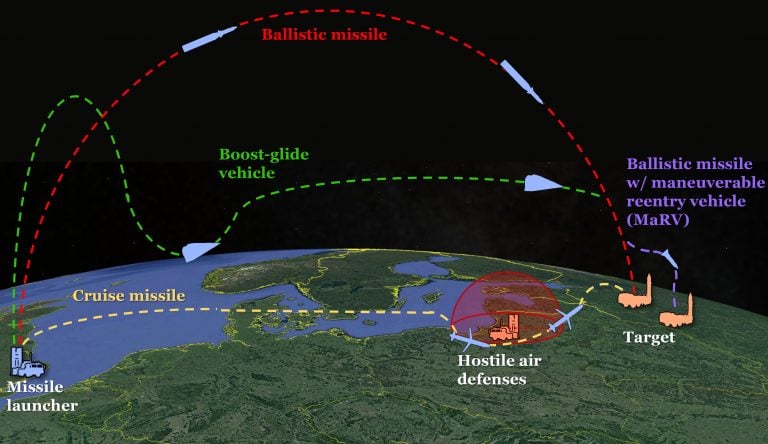- Reaction score
- 147
- Points
- 710
On the other hand--start and end:
Hypersonic missiles: Three questions every reader should ask
Interest in hypersonic weapons is taking off. The United States has for decades supported a modest research effort in such weapons, but now, spurred along by Russia and China, it’s ramping up efforts. Russian President Vladimir Putin used his 2018 address to the nation to announce the development of a hypersonic glider that he claimed would be able to get through all US defenses, and that weapon assumed combat duty this month. Meanwhile, even a cursory scan of the academic research literature shows a healthy presence in this field at Chinese universities, and the hypersonic DF-17 missile was all the rage at that country’s 70th anniversary parade in October. Michael Griffin, head of the Pentagon’s research and engineering, has stated that hypersonic weapons, and defense against them, were the military’s highest technical priorities.
Interest from the press has followed. Scan Google News for the word “hypersonic,” and three times as many hits come up in the last two years as in the previous two-year period. Several reports have appeared in the New York Times, Washington Post, Economist, and other leading general-interest publications, plus many more examples in the trade press.
One thing that jumps out from almost all of these pieces is a glaring lack of normal journalistic skepticism (with a few admirable exceptions). Indeed, some major pieces are downright fawning. The authors readily accept advocates’ claims that hypersonic weapons will move at blinding speeds, have extended range, be easily maneuverable, and strike targets with high precision without considering the engineering challenges or inherent physical limitations that will make this combination of capabilities difficult—if not impossible.
Why do reports on hypersonic weapons generally range from kid-glove treatment to cheer-leading? There are a few different things going on here. Hypersonic vehicles are really impressive and it is easy to be dazzled by their performance (or, more precisely, the performance that is claimed for them). After all, who doesn’t love Formula 1 racecars, speedboats, and anything else that moves fast? Aircraft that can fly through the air with such speed that bits of it start to glow red have an intrinsic appeal.
Analysts should, of course, see past the dazzle. But that reveals another great challenge for reporters covering this topic: the dearth of outside expertise or contrary views. Virtually anyone in the United States who has a solid technical understanding of hypersonic aerodynamics is working for the Defense Department, one of the national laboratories, a contractor working for Defense, or is a university researcher supported at least in part by Defense Department grants.
To be clear, this does not mean that the people doing this work and claiming great virtues for hypersonic vehicles are shills for something they know is nonsense. Quite the opposite. Why would anyone devote their life to hypersonic research if they did not think the work was more than simply intriguing but also important? And those with hands-on experience tend to be very forthcoming about the technical challenges. These are honest believers, but the funding realities tends to create enthusiasts rather than skeptics. There are a mere handful of people in the United States who have some scientific and technical understanding of hypersonic vehicles who are not working directly or indirectly for the military—and that means a very limited set of contrary views.
An early lack of naysayers almost always occurs when some new idea or proposed system first appears. A new idea gets pushed forward by enthusiasts and advocates and it takes a while for the analytical community to scratch its collective head and come back with: “Wait a second…”
...it’s clear that much of the motivation for the US hypersonic weapons program is mainly a reflexive response to Russian and Chinese developments: If they do it, then we should too. US government officials have been quite explicit that the American effort is intended, in part, to avoid falling behind in this “race” with Russia and China. Yet, the strategic challenges of each country are radically different. Russian leaders have said explicitly that their hypersonic efforts are in response to US missile defenses and US abrogation of the Anti-Ballistic Missile Treaty, and they might be telling the truth. Of the three countries, the United States is, indeed, working hardest on ballistic missile defenses. When looking out at the threats in the world, Russia and China have very different views than does the United States. There is no reason for the United States to go on autopilot and mirror-image their moves with regard to hypersonic weapons.
Perhaps this whole idea will collapse under its own weight, but not before the United States has spent several billion dollars. That’s why the analytical community shouldn’t wait. It’s bad to be cynical but good to be skeptical. Those who write about this new weapon should stop and take a breath—and ask hard, honest questions.
https://thebulletin.org/2019/12/hypersonic-missiles-three-questions-every-reader-should-ask/#
But might not hypersonics, esp. stealthy cruise missiles, be just the ticket for decapitation of most of an enemy's key C4ISR facilities? Amongst other things.
Mark
Ottawa
Hypersonic missiles: Three questions every reader should ask
Interest in hypersonic weapons is taking off. The United States has for decades supported a modest research effort in such weapons, but now, spurred along by Russia and China, it’s ramping up efforts. Russian President Vladimir Putin used his 2018 address to the nation to announce the development of a hypersonic glider that he claimed would be able to get through all US defenses, and that weapon assumed combat duty this month. Meanwhile, even a cursory scan of the academic research literature shows a healthy presence in this field at Chinese universities, and the hypersonic DF-17 missile was all the rage at that country’s 70th anniversary parade in October. Michael Griffin, head of the Pentagon’s research and engineering, has stated that hypersonic weapons, and defense against them, were the military’s highest technical priorities.
Interest from the press has followed. Scan Google News for the word “hypersonic,” and three times as many hits come up in the last two years as in the previous two-year period. Several reports have appeared in the New York Times, Washington Post, Economist, and other leading general-interest publications, plus many more examples in the trade press.
One thing that jumps out from almost all of these pieces is a glaring lack of normal journalistic skepticism (with a few admirable exceptions). Indeed, some major pieces are downright fawning. The authors readily accept advocates’ claims that hypersonic weapons will move at blinding speeds, have extended range, be easily maneuverable, and strike targets with high precision without considering the engineering challenges or inherent physical limitations that will make this combination of capabilities difficult—if not impossible.
Why do reports on hypersonic weapons generally range from kid-glove treatment to cheer-leading? There are a few different things going on here. Hypersonic vehicles are really impressive and it is easy to be dazzled by their performance (or, more precisely, the performance that is claimed for them). After all, who doesn’t love Formula 1 racecars, speedboats, and anything else that moves fast? Aircraft that can fly through the air with such speed that bits of it start to glow red have an intrinsic appeal.
Analysts should, of course, see past the dazzle. But that reveals another great challenge for reporters covering this topic: the dearth of outside expertise or contrary views. Virtually anyone in the United States who has a solid technical understanding of hypersonic aerodynamics is working for the Defense Department, one of the national laboratories, a contractor working for Defense, or is a university researcher supported at least in part by Defense Department grants.
To be clear, this does not mean that the people doing this work and claiming great virtues for hypersonic vehicles are shills for something they know is nonsense. Quite the opposite. Why would anyone devote their life to hypersonic research if they did not think the work was more than simply intriguing but also important? And those with hands-on experience tend to be very forthcoming about the technical challenges. These are honest believers, but the funding realities tends to create enthusiasts rather than skeptics. There are a mere handful of people in the United States who have some scientific and technical understanding of hypersonic vehicles who are not working directly or indirectly for the military—and that means a very limited set of contrary views.
An early lack of naysayers almost always occurs when some new idea or proposed system first appears. A new idea gets pushed forward by enthusiasts and advocates and it takes a while for the analytical community to scratch its collective head and come back with: “Wait a second…”
...it’s clear that much of the motivation for the US hypersonic weapons program is mainly a reflexive response to Russian and Chinese developments: If they do it, then we should too. US government officials have been quite explicit that the American effort is intended, in part, to avoid falling behind in this “race” with Russia and China. Yet, the strategic challenges of each country are radically different. Russian leaders have said explicitly that their hypersonic efforts are in response to US missile defenses and US abrogation of the Anti-Ballistic Missile Treaty, and they might be telling the truth. Of the three countries, the United States is, indeed, working hardest on ballistic missile defenses. When looking out at the threats in the world, Russia and China have very different views than does the United States. There is no reason for the United States to go on autopilot and mirror-image their moves with regard to hypersonic weapons.
Perhaps this whole idea will collapse under its own weight, but not before the United States has spent several billion dollars. That’s why the analytical community shouldn’t wait. It’s bad to be cynical but good to be skeptical. Those who write about this new weapon should stop and take a breath—and ask hard, honest questions.
https://thebulletin.org/2019/12/hypersonic-missiles-three-questions-every-reader-should-ask/#
But might not hypersonics, esp. stealthy cruise missiles, be just the ticket for decapitation of most of an enemy's key C4ISR facilities? Amongst other things.
Mark
Ottawa




/arc-anglerfish-arc2-prod-mco.s3.amazonaws.com/public/UG45C62FMJC6NJOXQ6HZGRUGTE.jpg)




